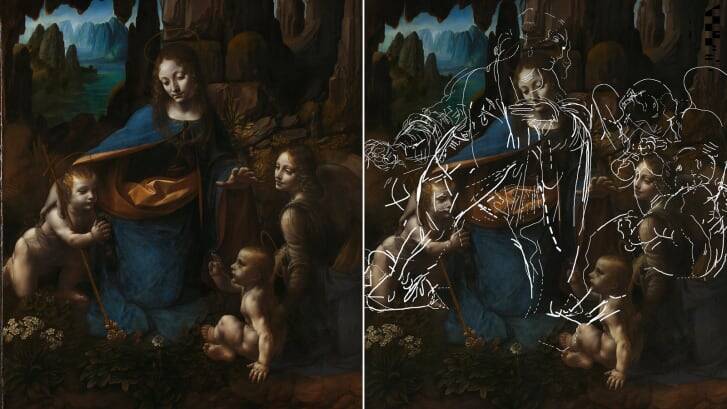- UID
- 20
- Online time
- Hours
- Posts
- Reg time
- 24-8-2017
- Last login
- 1-1-1970
|
|
━━━━━━━━━━━━━━━━━
Advanced technology has detected the sketch of a Da Vinci masterpiece hidden beneath the finished product as well as the artist's own handprints.

The National Gallery
The finished painting (left) and Da Vinci’s considerations mid-work in sketch form on the right.
▼ Museumgoers at London’s National Gallery have likely walked by and marveled at Leonardo Da Vinci’s 15th-century painting “The Virgin of the Rocks” without a clue as to what lay beneath. As it turns out, for the past 500 years, neither did anyone else.
According to CNN, a recent scientific analysis of the painting using new infrared and hyperspectral imaging revealed Da Vinci’s handprints and early sketches of the work underneath the final product.
The faint sketches show the angel and Baby Jesus in slightly different positions. Experts believe that Da Vinci later altered the final angle from which Christ was depicted in order to show the figure more clearly from a profile perspective.
“In the abandoned composition both figures are positioned higher up, while the angel, facing out, is looking down on the Infant Christ with what appears to be a much tighter embrace,” the National Gallery said in a statement.
According to LiveScience, the imaging process used to discover what lay beneath the finished painting was quite technologically sophisticated. Though researchers detected the tracings of a covered-up underpainting as early as 2005, modern tech has elucidated the work more clearly than ever before.
In order to fully reveal the underpainting, researchers used a combination of infrared reflectography, X-ray fluorescence (XFR) scanning, and hyperspectral imaging. The first technique was employed back in 2005 when researchers discovered that there was possibly an underpainting in the first place.
Even though the brushstrokes were covered by numerous layers of paint and were thus invisible in the visible spectrum, they weren’t hidden from infrared light. XFR scanning, meanwhile, illuminated useful individual elements when hit with X-ray light.
“These new images were found because the drawings were made in a material that contained some zinc, so it could be seen in the macro X-ray fluorescence (MA-XRF) maps showing where this chemical element was present, and also through new infrared and hyperspectral imaging,” the gallery said.
Hyperspectral imaging, which detects the electromagnetic energy emanating from a subject across a variety of spectra, made the finer remaining details visible. This technique allowed (▪ ▪ ▪)
► Please, continue reading this article here: Source |
|